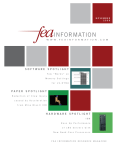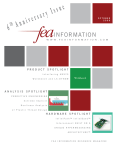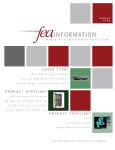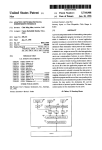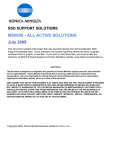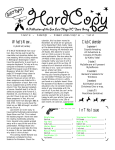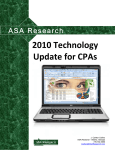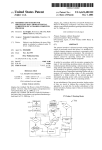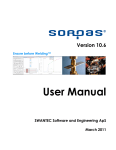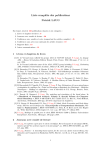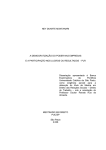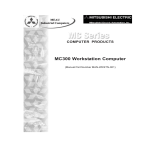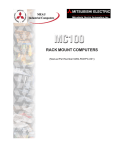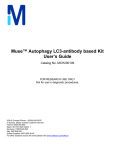Download FEA Newsletter December 2006 - Free of Papers from LS
Transcript
D E C E M B E R 2 0 0 6 I N F O R M AT I O N W W W . F E A I N F O R M A T I O N . C O M GRID CO M P U T I N G H P F l e x i b l e C o m p u t i n g S e rv i c e s P R ODUCT S o l u t i o n SPOTLIGHT E TA V P G / P r e P o s t V P G / S T R U C T U R E V P G / S A F E T Y H A R D WA R E S P O T L I G H T N E C P r o v i d e s S y s t e m L a r g e s t i n J a p a n S X - 8 R t o S u p e r c o m p u t e r O s a k a U n i v e r s i t y 's C y b e r m e d i a F E A I N F O R M AT I O N C e n t e r R E S O U R C E M A G A Z I N E FeaInformation.com FEA Information Worldwide Participants 01 02 03 07 08 09 10 15 Index FEA Announcements LS-DYNA Features in Hot Stamping – A. Shapiro FEA New AVI’s HP – Experience LS-DYNA By The Hour LS-DYNA Initial Penetrations in Contact Interfaces Yahoo Yammerings India – New Distributor of Oasys pre- and post- Software NEC – Press Release Largest SX-8R Supercomputer System in Japan to Osaka 16 University's Cybermedia Center 18 Web page highlighted - VPG developed by ETA 19 Industry Press Release Excerpts 20 5th German LS-DYNA Forum Review 21 LS-PrePost 22 LSTC 2007 Training Schedule 24 LS-DYNA Events 25 LS-DYNA Resource Page 31 November News Page Highlights 32 Hardware & Computing and Communication Products 33 Software Distributors 35 Consulting and Engineering Services 36 Educational & Contributing Participants 37 China Participants 39 Informational Websites Technical Writers: Editor: Dr. David Benson Art Shapiro Uli Franz Managing Editor: Dr. Ala Tabiei Marsha Victory Suri Bala Graphic Designer: Technical Consultants: Wayne L. Mindle Steve Pilz - Reza Sadeghi 1 FeaInformation.com FEA Information Announcements FEA News: We have posted new AVI’s in the on-line AVI library 2007 sites are being redesigned: • For better performance in IE • New Site Feb 2007: LS-DYNA Resources • New Site Feb 2007: LS-DYNA Consultants FEA News Travel: Marsha Victory will be traveling on business to China January 28 – Feb 03 – Beijing and Shanghai. LSTC News: 2007 LSTC Classes are now posted on the LSTC website Sincerely, Art Shapiro [email protected] Marsha J. Victory [email protected] The content of this publication is deemed to be accurate and complete. However, FEA Information Inc. doesn’t guarantee or warranty accuracy or completeness of the material contained herein. All trademarks are the property of their respective owners. This publication is published for FEA Information Inc., copyright 2006. All rights reserved. Not to be reproduced in hardcopy or electronic copy. Note: All reprinted full articles, excerpts, notations, and other matter are reprinted with permission and full copyright remains with the original author or company designated in the copyright notice 2 FeaInformation.com 3 LS-DYNA Publication LS-DYNA® Features for Hot Stamping Copyright © 2006 Livermore Software Technology Corporation 9th International LS-DYNA Users Conference Arthur B. Shapiro LS-971 has several new features to model the hot stamping process. A thick thermal shell formulation allows modeling a temperature gradient through the thickness of the shell. The new keyword, *MAT_ADD_THERMAL_EXPANSION, allows calculating thermal strains for all the mechanical material models. A new feature has been added to thermal contact which turns off thermal boundary conditions when surfaces come in contact. A new thermal one-way contact algorithm has been added which more accurately models heat transfer between a blank and die. New features have been added to thermalmechanical contact which allows modeling the coefficients of friction as a function of temperature and thermal contact resistance as a function of interface pressure. Units A consistent set of units must be used in performing a coupled thermal-mechanical analysis. Problems arise due to a mismatch between the mechanical unit for work and the thermal unit for energy. SI presents a consistent set of units to perform a coupled thermal mechanical analysis. However, units are typically chosen based on historical practice in the industry. Table 1 presents typical units used for metal stamping. There are 2 approaches that can be taken to satisfy the requirement of a consistent set of units. 1. Convert the thermal units into the base units being used for the mechanical problem. This is done for unit sets 1 and 2 in Table 1. The mechanical units for Unit Set 1 are defined in a way that the thermal units are in joules and watts. This is not the case for Unit Set 2. Although Unit Set 2 is consistent, the thermal units are not familiar. 2. Use the SI unit for thermal energy, the joule, and define the mechanical equivalent of heat to convert the mechanical work unit into joules. This is done for Unit Set 3. The mechanical equivalent of heat is entered in the *CONTROL_THERMAL_SOLVER keyword. Hot Forming Process The hot forming process has 5 steps [1]: 1. Austenization Æ The blank is heated and held at the austenization temperature of 950C. 2. Transfer Æ The blank cools by convection and radiation during transfer from the oven to the forming press. 3. Positioning Æ The blank is placed on the lower die and begins to cool due to contact with the colder die. 4. Forming Æ The blank is formed. 5. Quenching Æ The blank is held in the press and cooled to induce a solid-solid phase transition from austenite to martensite. FeaInformation.com 4 1. Austenization 2. Transfer 3. Positioning 4. Forming 5. Quenching Austenitizati on Thick Thermal Shell The blank is modeled by a thin mechanical shell and flagged to be treated as a thick thermal shell by the parameter TSHELL on the *CONTROL_SHELL keyword. The thick thermal shell is a 12 node element – 4 nodes in the plane of the shell and 3 nodes through the thickness. The 3 nodes through the thickness allow the use of quadratic shape functions to more accurately calculate the through thickness temperature gradient. LS-PrePost can display temperatures on the mid-plane, bottom surface, and top surface of the shell. *MAT_ADD_THERMAL_EXPANSION The coefficient of thermal expansion as a function of temperature can be defined using the *MAT_ADD_THERMAL_EXPANSION keyword. This allows the calculation of thermal strains for any of the mechanical material models in LS-DYNA. LS-DYNA requires the tangent value of the coefficient of expansion as defined in the following figure. Thermal Mechanical Contact Two new features have been added to the *CONTACT_option_THERMAL keyword. 1. bc_flag Æ During the transfer operation from the oven to the press both surfaces of the blank lose heat to the environment. However, once the blank is positioned on the lower die, only the top surface of the blank transfers heat to the environment. Setting bc_flag=1 turns off thermal boundary conditions for those surfaces that are in contact. 2. 1_way Æ In the mechanical definition of the problem, the dies are typically modeled using a rigid material. Therefore, the dies do not deform. Analogously for the thermal definition of the problem, the dies do not change temperature because their mass is much greater than that of the blank. FeaInformation.com 5 The parameter 1_way invokes this modeling assumption – only the blank can change temperature due to contact. The suffix FRICTION added to the keyword *CONTACT_option_THERMAL_FRICTION adds the capability to model the mechanical coefficients of friction as a function of temperature and the thermal contact resistance as a function of interface pressure. There are currently 4 formulas to calculate the contact resistance, h, as a function of interface pressure, P: 1. load curve h(P) is defined by a load curve 2. polynomial h(p) = a + bP + cP2 + dP3 0.8 πk gas ⎡ ⎛P⎞ ⎤ h( P ) = 3. Shvets formula [2] ⎢1. + 85⎜ ⎟ ⎥ 4λ ⎢⎣ ⎝ σ ⎠ ⎥⎦ ⎡ P ⎞⎤ ⎛ 4. Sellers formula [3] h( P ) = a ⎢1. − exp⎜ − b ⎟⎥ c ⎠⎦ ⎝ ⎣ Other formulas will be added in the future. d MAT_113 [4] and Thermal User Subroutine Material type 113 applies to shell elements only. It features a special hardening law aimed at modeling the temperature dependent hardening behavior of TRIP-steels. TRIP stands for Transformation Induced Plasticity. The material gains ultra high strength through the hot forming process. In this material, a phase transformation from austenite to martensite occurs during forming, an effect which is sensitive not only to the stain level, but also to strain rate and temperature. The material model is composed of 2 basic equations: 1. TRIP kinetics rate equation ∂Vm B ⎛ Q ⎞⎛ 1 − Vm = exp⎜ ⎟⎜⎜ A ∂ε ⎝ T ⎠⎝ Vm ⎞ ⎟⎟ ⎠ (1+ B ) B VmP 1 (1 − tanh(C + DT )) 2 2. yield stress equation σ y = {B HS − (B HS − AHS ) exp(− mε n )}(K 1 + K 2T ) + ΔH γ →α Vm The user subroutine allows the creation of more sophisticated material models with the interchange of material history variables between the mechanical material user subroutine and the thermal material user subroutine. 1. 2. 3. 4. References Figure courtesy of David Lorenz, DaimlerChryler, Mercedes Car Group, Germany. I.T. Shvets, “Contact Heat Transfer Between Plane Metal Surfaces”, Int. Chem. Eng., Vol. 4, No. 4, p621, 1964. Li & Sellers, Proc. Of 2nd Int. Conf. Modeling of Metals Rolling Processes, The Institute of Materials, London, 1996. D. Hilding & E. Schedin, “Experience from Using a New Material Model for Stainless Steels with TRIP-effect”, 5th European LS_DYNA Users Conference, Birmingham, UK, 2005. m Length mm mm ton mm Unit Set 3 ton Unit Set 2 kg Unit Set 1 kg SI Mass s s ms s Time N N kN N Force MPa MPa Gpa Pa Pressure N mm N mm Nm=J Nm=J Work or Energy ton/mm3 7.87e-09 1.e-03 2.05e+05 MPa 2.05e+05 7.87e-09 1. 10-3J/N mm MPa ton/mm3 2.05e+02 7.87e-06 1. Not Applicable GPa kg/mm3 2.05e+11 7.87e+03 1. J/kN mm Pa Elastic Modulus kg/m3 Density J/Nm Mechanical Equivalent of Heat 5.19e-02 W/mm K 5.19e+01 ton mm/s3 K 5.19e-05 kW/mm K 5.19e+01 W/m K Thermal Conductivity 4.86e+05 J/ton K 4.86e+08 mm2/s2K 4.86e+02 J/kg K 4.86e+02 J/kg K Heat Capacity Table 1: Shown are typical unit sets used for metal stamping. Properties are for 1020 cold rolled steel. 1.e-06 W/mm2 1.e-03 ton/s3 1.e-09 kW/mm2 1. W/m2 Flux FeaInformation.com 6 FeaInformation.com LS-DYNA December AVI’s posted Complete AVI’s are located at: www.feainformation.com top bar link “AVI Lib” AVI’s courtesy of Gaurav Nilakantan, University of Cincinnati, OH, USA Site: Drop Testing – Page Gallery 59 59a 59b Fabric Impact by RCC Platform Drop Test with energy absorbing element Dynamic axial crushing of cylindrical shell AVI’s courtesy ENSICA, France Site: LS-DYNA – Page Metal Cut 613-613d – Metal cutting 7 FeaInformation.com 8 Experience LS-DYNA® by the hour… FREE!! A 5,000+ hour HP Flexible Computing Services utility computing trial to qualified LS-DYNA commercial customers A $4,500 value, this offer includes: Flexible IT for your most demanding jobs © Copyright Hewlett Packard 04/2006 • • • • • 16 Xeon 64-bit CPU’s for 2 weeks (5,376 CPUhours LS-DYNA MPP version 971 Redhat Enterprise Linux HP MPI SSH connectivity Take advantage of this offer NOW to ensure your access to capacity! Here’s all you need to do: 1. Go to the HP Web page shown at the bottom of this offer page and click as instructed 2. Enter some basic qualification information… that’s it! HP will: 1. Contact you within 2 business days to confirm your information 2. Schedule your trial 3. Provide you with instructions for access to the HP Flexible Computing Services utility 4. Provide you with Instructions for submitting your LS-DYNA jobs. About the LS-DYNA HP Flexible Computing Services Solution Hewlett-Packard delivers a new, complete LS-DYNA Utility Computing Service under the HP Flexible Computing Services portfolio. This unique utility computing service offers LS-DYNA customers servers, networking, storage and LS-DYNA licensing, all hosted at a highly secure, HPowned data center. With the production service you can: • • • Tap into a complete, by-the-CPU-hour LS-DYNA service Pay only for the CPU-hours reserved, no long-term financial commitment Access industry standard Xeon, Opteron, and Itanium systems • • Choose Linux, Windows, or Unix operating systems Extend your in-house LS-DYNA resources with HP FCS and your LS-DYNA OS Pay As You Go Computing The LS-DYNA HP Flexible Computing Service is a pay-as-you-go service. There is no long-term financial commitment necessary. You can use it once and pay only for the hours of service you reserved. It is designed to extend and complement your in-house LS-DYNA resources. Terms of offer: Offer is valid for North America-based LS-DYNA commercial customers and is subject to qualification. Agreement with HP Flexible Computing Services and LS-DYNA terms of use is required. Introductory session includes infrastructure, OS, and LS-DYNA software as described. Offer is subject to compute resources available at the time of request. Agreement with additional terms is required with the purchase of production-level LS-DYNA HP Flexible Computing Services. For more information, or to sign up for this offer, go to http://www.hp.com/services/flexiblecomputing and click on: FeaInformation.com FEA Publication – Abstract – Complete Article is posted on FEA Publications - side bar link “Featured” Initial Penetrations in Contact Interfaces Suri Bala - Copyright © 2006 Livermore Software Technology Corporation 1. Introduction Contact definitions allow the modeling of interaction between one or more parts in a simulation model and have become a necessity in any small or large deformation problem. The main objective of the contact interfaces is to eliminate any “overlap” or “penetration” between the interacting surfaces and they accomplish this by first detecting the amount of penetration and then applying a force to remove them. Depending on the type of algorithm used to remove the penetration, both energy and momentum is conserved. This article discusses the presence of penetration in non-tied penalty-based contact interfaces during the initialization of the problem, usually termed as “initial penetration”, its effects on the accuracy, robustness of the model and how LS-DYNA has features that can minimize its adverse effects. 2. Detecting Penetrations In order to detect the penetration due to contact, LS-DYNA first performs a global search using the Bucket-Sort approach and then a local search using the incremental search technique, to find the closest master segment for any given slave node or a segment. Once a closest segment is found, it projects the slave nodal coordinates onto the closest master segment to compute its orthogonal distance. This is shown in Figure 1. The projected normal distance is computed using a local coordinate system that is embedded in the master segment and is updated every cycle. Based on the sign of the projected distance, LS-DYNA determines if the node is inside (penetration) or outside (no-penetration) the master segment. Projected distance that is less than 0 indicates that a penetration has occurred while a positive projected distance indicates a no penetration condition. 3. Initial Penetration Initial penetration is a term used frequently to describe the amount of penetration that exists between a node and its closest master segment (in the case of classic node/segment treatment) or between two interacting segments (in the case of “segment-based” treatment) during the initialization of the problem. This is shown in Figure 2 by considering only the thickness on the master segment for simplicity. 9 FeaInformation.com 10 Yahoo Group Yammerings Note: LS-DYNA Yahoo Group is neither owned nor operated by LSTC, and LSTC has no control over the content. Jim Kennedy KBS2 Inc. [email protected] Len Schwer Schwer Engineering & Consulting Services [email protected] The LS-DYNA Yahoo Group archives contains a wealth of information that can be helpful to any LS-DYNA user. We suggest you review the archives when you are seeking help on any topic related to LS-DYNA. This installment of “Yahoo Yammerings” features five questions, with responses, from the past month of postings to the LS-DYNA Yahoo Group. 1. 2. 3. 4. 5. Is *CONTROL_ADAPTIVE valid for SECTION_SOLID (ELFORM 1 or 3)? Sliding Interface energy for single surface contact definition? Why the fluid does not move? Extra history variables for different material models? Bolt preload / Angular velocity / Impact? Question: Is *CONTROL_ADAPTIVE valid for SECTION_SOLID (ELFORM 1 or 3)? Is *CONTROL_ADAPTIVE valid for SECTION_SOLID (ELFORM=1; constant stress solid) or (ELFORM=3; fully integrated 8 node solid with nodal rotations) or it is only for SHELL elements in LS-DYNA 970 ? In one case there is no error and there is a normal termination with *CONTROL_ADAPTIVE with SECTION_SOLID (ELFORM=3) . The d3plot files d3plot aa, ab (up to d3plotav were produced) etc are O.K, but the adapt.rid file is showing no remeshed elements. Post processing also shows no remeshing. Can anyone throw some light SECTION_SOLID (ELFORM 1 or 3)? on use of *CONTROL_ADAPTIVE with Reply by Jim Kennedy I suggest that you read Page 7.8 of the LS-DYNA Version 970 User’s Manual. There is an option there that allows you to use solid element adaptivity (ADPOPT=7). When using this feature, ELFORM=1 or 3 formulation inputs are automatically changed to ELFORM=13 (1-point nodal pressure tetrahedrons). You also might want to look at Page 8.8 of the LS-DYNA Version 971 User’s Manual; ELFORM=41 (mesh-free) appears to be a new option. FeaInformation.com Reply by Suri Bala For solid elements, R- Adaptivity is supported which needs to be selected using ADPOPT in *PART keyword. Only tetrahedron remeshing is supported and the initial mesh CAN be a composed of brick or wedge elements. Subsequent remeshing will only be done using 4-noded tetrahedron elements. Parameters for controlling the remeshing algorithm can be specified using the *CONTROL_REMESHING keyword. Choosing the min and max element edge lengths that are close to the initial mesh may be a good start with min-max range flexible enough for remeshing. Few additional notes: Nodes of the part being remeshed must not be used in any references, and the use of BOX or SET_PART is recommended. The part must be an isolated part since new nodes created due to the remeshing process would detach the adjacent component if it had any shared node with its neighbors. Element formulation Type 10 is recommended, but if the initial mesh is composed of elements other than tetrahedron elements, *CONTROL_RIGID must be used with ESORT=1 to toggle automatic sorting of elements based on type so the correct element formulation is chosen. Beginning with Version971, you can export the time-history data for mass and CG. (global or part-level) and it is highly recommended to output these parameters for the remeshed part to ensure conservation of mass and volume. Question: Sliding Interface energy for single surface contact definition? I am trying to track the rubbing work done on a contact definition as shown below. The SLEOUT ASCII file energies for this definition seems to be nonsense when I look at the energy history in LS-PREPPOST. Other contact definitions in my model are producing good output. *contact_eroding_single_surface 777,,2 .3,.3,,,20,,.029,1 1,1 0,1,1 *contact_single_edge 777,,2 .3,.3,,,20,,.029,1 1,1 11 FeaInformation.com I recall reading, but cannot find this again so I might be wrong, that single surface definitions require further cards to track the sliding work done. Does anyone know where this information is found? Reply by Jim Kennedy Perhaps this may be of some interest. Reminder: the sliding interface energy, *DATABASE_SLEOUT, requires a flag on the *CONTROL_ENERGY keyword. If you have more than one contact defined, the SLEOUT file (*DATABASE_SLEOUT) will report contact energies for each contact. When specifically looking for certain contact forces/energy of defined segments where physical contact occurs, you might consider: *CONTACT_TRANSDUCER_PENALTY *CONTACT_TRANSDUCER_CONSTRAINT These contacts will allow you to obtain contact forces/energy; however, no force is applied to the model, even though it is a contact definition. I also suggest that you look at Chapter 5.0 Contact Output of Suri Bala’s notes: Bala, Suri, “Contact Modeling in LS-DYNA - Parts 1, 2, 3, and 4,” Livermore Software Technology Corporation, 2001. (August, September, October, December, 2001 FEAInformation Newsletters) http://www.feapublications.com/pages/feanews2.shtml An example of the suggested transducer data structure is given in Chapter 23.2 Contact Definitions (see Page 23.17) of the following guide: Weimar, K., "LS-DYNA User's Guide," CAD-FEM GmbH, Rev. 1.19, September, 2001. http://portal.ecadfem.com/fileadmin/files/lsdyna/website/pdf/pdf_lsdyna/Users_Guide.pdf Question: Why the fluid does not move? I use LS-DYNA to simulate a cylinder of water impacting an elastic material. But to my surprise the water did not move as expected. I hope I can get your help. Reply by Jim Kennedy If you are having trouble with visualization; with a recent LS-PREPOST executable, you can view the Euler/ALE materials in a convenient manner by selecting SELPAR > FLUID. You can also view the Euler/ALE materials using FCOMP > MISC> HISTORY VAR#. 12 FeaInformation.com HISTORY VARIABLE #: 1 = density 2 = volume fraction of 1st multi-material group (formulation 11) or single Eulerian material (formulation 12) 3 = volume fraction of 2nd multi-material group (formulation 11) etc. If n is the number of multi-material groups, then history variable #(n+2) is a component that identifies the various multi-material groups by assigning a value of 1.0 to those cells comprised predominantly of multi-material group 1, 2.0 to those cells comprised predominantly of multi-material group 2, and so on. If STRFLG is set to 1 (strains are saved), the first six extra history variables for the Euler/ALE solid elements are strains. Thus, in that case density will be the 6+1=7th history variable. It’s sometimes more clear to view iso-surfaces of Eulerian history variables rather than fringes (click on the FRIN button and choose ISOS). Question: Extra history variables for different material models? Does anyone know the meaning of “extra history variables” for MAT22 and MAT59? As far as I know the LS-DYNA manual only defines those post-processing variables for MAT54/55? Reply by Jim Kennedy The MAT_022 information is on Page 20.92 of the LS-DYNA Version 970 User’s Manual. I recommend getting a copy of the LS-DYNA Version 971 User’s Manual for this additional information: http://www.dynamax-inc.com/download.htm The meaning of the extra history variables for MAT_022 are given on Page 23.106 of the LS-DYNA Version 971 User’s Manual. As for MAT_059, you will have to follow the advice in the note further down in this message. In the table provided on Pages 23.1 to 23.6 of the LS-DYNA Version 971 User’s Manual, for each material, the number of history variables is listed. The following note offers some discussion on extra history variables which hopefully will be of some help: http://www.dynasupport.com/Support/howto/ale.history.variables 13 FeaInformation.com LS-DYNA Yahoo Groups There are over 2037 subscribers from all over the world, and this list seems to grow by a hundred new subscribers ever few months; no small testament to the rapidly growing popularity of LS-DYNA. The group currently averages about 200 message per month, i.e. about 7 message per day. You can subscribe to the group by sending an email request to [email protected] or by visiting the Yahoo Groups web site http://groups.yahoo.com Generally, the quickest/best responses are to those questions posed with the most specifics. General questions such as “How do I use XXX feature?” either go unanswered, or are answered by Jim Kennedy with links to appropriate references in the growing LS-DYNA related literature, e.g. see the archive of LS-DYNA Conference proceedings at www.dynalook.com 14 FeaInformation.com 15 New Distributor of the Oasys pre- and post- processing software and FE models in India Arup is pleased to announce the appointment of nHance Engineering Solutions Pvt. Ltd. as a distributor of the Oasys software and FE model products in India Oasys LS-DYNA Environment Arup’s software for use with LS-DYNA consists of PRIMER (pre-processor), D3PLOT and T/HIS (post- processors) and REPORTER (automatic report generation). We also produce a graphical user interface for submitting and monitoring jobs called the Oasys SHELL. nHance Engineering Solutions Pvt Ltd was established in 2004 to provide software development resources to Oasys and to Arup divisions. Over the last two and half years, nHance's team has grown to 14 members in size and the team's involvement has spread to all aspects of software development and to all Oasys structural, geotechnical and document management products. A recent addition is the start of a small team to work with and distribute the Oasys pre-and post-processing software for LS-DYNA OASYS LS-DYNA FE Models Arup has developd correlated LS-DYNA models of barriers and pedestrian impactors for various automotive test simulations. These models are used widely in the automotive industry. Contact Information Lavendra Singh NHance Engineering Solutions Pvt. Ltd. +91 (0) 40 23544420/28 [email protected] www.arup.com FeaInformation.com 16 December Chosen Press Release (Tokyo, November 7, 2006) NEC to Provide Largest SX-8R Supercomputer System in Japan to Osaka University's Cybermedia Center Tokyo, November 7, 2006 ---NEC Corporation (NEC) announced the purchase of a large-scale supercomputer system consisting of 20 SX-8R vector supercomputers by the Cybermedia Center (CMC) at Osaka University. The new system achieves a peak performance of 5.3 TFLOPS and will be the largest SX series system acquired in Japan. CMC plans to add a next-generation SX system in two years, whose peak performance is expected to exceed 20 TFLOPS (one trillion floating-point operations per second), a performance enhancement of 16 times that of the current system of SX-5/12M8 (peak performance: 1,280GFLOPS). The Cybermedia Center at Osaka University was established in April 2000 and is a joint product of the former Computing Center (CC) and related departments of Osaka University. The center has continually deployed computing systems of the highest levels and provided computational resources for large and high-speed calculations to researchers in a wide range of areas across Japan, resulting in significant achievements in large-scale simulations in multiple and varied fields. CMC has highly evaluated NEC's system for its user-friendly programming realized by high sustained performance and largescale shared memory, which has been proved on benchmark tests with the user's actual applications. Recently, cluster systems, which consist of many CPUs connected in parallel, have shown a great improvement in performance, achieving well in areas such as molecular science, semiconductor design, structural analysis and bio informatics. However, in the areas of fluid and particle analysis, vector supercomputers continue to demonstrate absolute dominance in terms of CPU performance and calculation efficiency when compared with cluster systems. In addition, efficiency improvement in power consumption and installation make vector supercomputers superior in operation cost to that of cluster systems. FeaInformation.com NEC launched sale of the world's fastest commercial vector supercomputer SX-8R in October 2006. The SX-8R boasts a peak vector performance of 144 TFLOPS and demonstrates high performance in the areas of automotive performance, weather forecasts and environment simulations, where large-scale, largecapacity data calculations are required. About NEC Corporation: NEC Corporation (NASDAQ: NIPNY) is one of the world's leading providers of Internet, broadband network and enterprise business solutions 17 dedicated to meeting the specialized needs of its diverse and global base of customers. NEC delivers tailored solutions in the key fields of computer, networking and electron devices, by integrating its technical strengths in IT and Networks, and by providing advanced semiconductor solutions through NEC Electronics Corporation. The NEC Group employs more than 150,000 people worldwide and had net sales of approximately 4,825 billion yen (approx. $41.2 billion) in the fiscal year ended March 2006. For additional information, please visit the NEC home page at: http://www.nec.com Newsroom: http://www.nec.co.jp/press/en/ FeaInformation.com December’s Introduction Web Page VPG developed by ETA 18 (excerpt) www.eta.com VPG is delivered to users in 3 modules: VPG/PrePost: Provides a wide range of tools that can be used to efficiently create meshes on CAD data, using an advanced automeshing algorithm, which eliminates most manual mesh manipulation. The results ? better quality models in a fraction of the time VPG/Structure: VPG enables users to create unique system level simulations of mechanical systems such as vehicle suspensions and linkages. VPG enables users to include components as flexible bodies, combining the traditional kinematic/dynamic simulation methods with finite element analysis methods. The results are simulations that provide greater insight and opportunities to improve or prove out your design. VPG/Safety: With a complete dummy library, barrier library and airbag folding system, VPG enables users to quickly and painlessly set-up complex simulations for standard vehicle impact simulations. The "Process Guidance" approach to process automation delivers the flexibility that is needed by users, with a streamlined model creation. VPG users can quickly and reliably create simulation models that previously took a great deal of expertise and time to create. For futher information on eta/VPG Features and Modules visit www.eta.com Or contact: eta/VPG: Tim Palmer - Tel: +1 (248) 729-3010 x 239 Email: [email protected] FeaInformation.com December Industry News 19 (excerpts) Alpha Order Fujitsu PRIMERGY Servers Powered by Quad-Core Intel®Xeon® Processors Set Industry Performance Standard MSC.Software Announces New Global Impact Program Partners to Market and Deliver SimOffice® Systems Achieve Dramatic Improvements in Performance and Address Power and Cooling Challenges Leading Reseller Partners to Provide Manufacturers of All Sizes with the Industry's First Windows Vista Compatible Desktop Simulation Environment SUNNYVALE, Calif., December 5, 2006 — Fujitsu Computer Systems Corporation today announced five new PRIMERGY® two socket servers that offer Fujitsu customers even more choices for highly reliable servers: tower models TX200 S3 and TX300 S3, rack-based models RX200 S3 and RX300 S3, and a blade server BX620 S3. All servers feature the latest Intel® Quad-Core Xeon® processors E5310 and E5320, which deliver almost double the performance per watt over the latest generation of Intel® dual-core processors. Complete Announcement Fujitsu SANTA ANA, Calif. - December 4, 2006 - MSC.Software Corp. (NASDAQ: MSCS),… SimOffice allows manufacturers to leverage existing IT investments and simulation environments through the entire suite of Microsoft productivity and collaboration solutions including Windows Vista, Microsoft Office Sharepoint and Microsoft Office Groove. With SimOffice, organizations who either may not yet be taking advantage of simulation or for whom it is a smaller part of their business can gain a competitive edge by improving productivity through fast, reliable simulation in an easy-to-use next generation Windows Vista desktop environment. Complete Announcement MSC.Software FeaInformation.com 20 5th German LS-DYNA Forum The German LS-DYNA Forum was a great success. 260 visitors attended the conference on the various LS-DYNA applications. In total more than 80 papers were presented on LSDYNA, LS-OPT and LS-PrePost. The presentations were given by users from: OEMs: And Audi, BMW, DaimlerChrysler, Ford, Opel, Porsche, Toyota Auto Body, Volkswagen Suppliers, Engineering Services Companies, Research Institutes, Universities. The program can be downloaded at: http://www.dynamore.de/download/af06/inv_V1b_e_web.pdf The papers can be downloaded at: http://www.dynamore.de/event/af06/con_event_agenda.php FeaInformation.com 21 LS-PrePost® Online Documentation News Update www.lstc.com/lspp © Copyright LSTC Online documentation is provided by the developers of LS-PrePost and is continually updated. LS-PrePost, as well as LS-OPT are delivered with LS-DYNA at no additional fees. LS-PrePost is an advanced pre and post-processor. The user interface is designed to be both efficient and intuitive. LS-PrePost runs on Windows, Linux, and Unix utilizing OpenGL graphics to achieve fast rendering and XY plotting. What’s New in LS-PrePost 10-Dec - Added Delete Degenerated Elem option to DupNod Interface to allow control over deletion of degenerated elements 01-Dec - Added a few Animated Demos to the Tutorials section 26-Nov - Added scroll wheel zooming as a standard Mouse Operation 22-Nov - Added some Mini Tutorials to address specific topics 16-Nov - Added asksave option to Configuration File 15-Nov - Added Save Keyword As option to File Menu to standardize file save behavior FeaInformation.com LSTC Training Classes: 22 2007 Classes The California office training center accommodates 23 students. The Michigan office has capacity for 12 students. Classes are scheduled throughout the year at both locations. For the most current schedule visit 132Hwww.lstc.com Onsite training is also available. We are in the process of scheduling all the classes. Training Classes As of today we have: US $ California Advanced LS-DYNA for Impact Analysis $950 June 26-29 Sept 25-28 Advanced Options in LS-DYNA $750 March 20-21 ALE/Eulerian & Fluid/Structure Interaction in LS-DYNA $750 Feb 14-16 Composite Materials $750 June 14-15 Concrete and Geomaterial Modeling with LS-DYNA $1,000 Sept 06-07 Nov 01-02 Jan 15-16 June 12-13 Contact in LS-DYNA $750 Heat Transfer & Thermal-Stress Problems $500 Implicit $750 March 22-23 Introduction to LS-DYNA $750 Feb 06-09 May 01-04 Classes are continued on Next Page Michigan Dec 10-11 Dec 12-13 March 13-16 June 05-08 Sept 11-14 FeaInformation.com LSTC Training Classes: 23 2007 Classes Continued Introduction to LS-OPT $750 LS-DYNA Composite Materials $750 LS-DYNA Implicit $750 LS-DYNA for Heat Transfer & Thermal-Stress Problems $500 Material Modeling Using LS-DYNA User Defined Options $750 MESH Free Methods in LS-DYNA (SPH and EFG) $750 June 18-19 FeaInformation.com EVENTS – 2006 If you want your event listed please send the information to: [email protected] 2007 May 28-29 6th European, Sweden July 23-26 Ninth US National Congress on Computational Mechanics, San Francisco, CA - USNCCM-IX October 1112 LS-DYNA Users Meeting - Germany - hosted by DYNAmore October 3031 Japan LS-DYNA Users Conference 2007 - hosted by JRI 2008 June 8-10 8th International Users Conference, Dearborn, MI, US 24 FeaInformation.com 25 LS-DYNA Resource Page Interface - Hardware - OS And General Information Participant Hardware/OS that run LS-DYNA (alphabetical order). LS-DYNA has been fully QA’d by Livermore Software Technology Corporation for All Hardware and OS listed below. TABLE 1: SMP TABLE 2: MPP Interconnect and MPI TABLE 1: SMP - Fully QA’d by LSTC AMD Opteron Linux FUJITSU Prime Power SUN OS 5.8 FUJITSU VPP Unix_System_V HP PA-8x00 HP-UX 11.11 and above HP IA-64 HP-UX 11.22 and above HP Opteron Linux CP4000/XC HP Alpha True 64 IBM Power 4/5 AIX 5.1, 5.2, 5.3 IBM Power 5 SUSE 9.0 INTEL IA32 Linux, Windows INTEL IA64 Linux INTEL Xeon EMT64 Linux NEC SX6 Super-UX SGI Mips IRIX 6.5 X SGI IA64 SUSE 9 with ProPack 4 Red Hat 3 with ProPack 3 FeaInformation.com 26 LS-DYNA Resource Page MPP Interconnect and MPI FEA Information Inc. Participant’s (alphabetical order) Fully QA’d by Livermore Software Technology Corporation TABLE 1: SMP - Fully QA’d by LSTC AMD Opteron Linux FUJITSU Prime Power SUN OS 5.8 FUJITSU VPP Unix_System_V HP PA-8x00 HP-UX 11.11 and above HP IA-64 HP-UX 11.22 and above HP Opteron Linux CP4000/XC HP Alpha True 64 IBM Power 4/5 AIX 5.1, 5.2, 5.3 IBM Power 5 SUSE 9.0 INTEL IA32 Linux, Windows INTEL IA64 Linux INTEL Xeon EMT64 Linux NEC SX6 Super-UX SGI Mips IRIX 6.5 X SGI IA64 SUSE 9 with ProPack 4 Red Hat 3 with ProPack 3 FeaInformation.com 27 TABLE 2: MPP Interconnect and MPI Vendor AMD Opteron O/S HPC Intereconnect MPI Software Linux InfiniBand (SilverStorm), MyriCom, QLogic InfiniPath LAM/MPI, MPICH, HP MPI, SCALI FUJITSU Prime SUN OS 5.8 Power FUJITSU VPP Unix_System_V HP PA8000 HPUX HPIA64 HPUX HP Alpha True 64 IBM Power 4/5 AIX 5.1, 5.2, 5.3 IBM Power 5 SUSE 9.0 INTEL IA32 Linux, Windows INTEL IA64 Linux INTEL Xeon EMT64 Linux NEC SX6 Super-UX SGI Mips IRIX 6.5 SGI IA64 SUSE 9 w/ProPack 4 NUMAlink, InfiniBand, (VolRedHat 3 w/ProPack taire) 3 LAM/MPI InfiniBand (Voltaire), MyriCom LAM/MPI, MPICH, HP MPI, SCALI LAM/MPI, MPICH, HP MPI InfiniBand (Topspin, Voltaire), MyriCom, QLogic InfiniPath LAM/MPI, MPICH, HP MPI, INTEL MPI, SCALI NUMAlink MPT MPT, Intel MPI, MPICH FeaInformation.com 28 LS-DYNA Resource Page - Participant Software Interfacing or Embedding LS-DYNA Each software program can interface to all, or a very specific and limited segment of the other software program. The following list are software programs interfacing to or having the LS-DYNA solver embedded within their product. For complete information on the software products visit the corporate website. ANSYS - ANSYS/LS-DYNA ANSYS/LS-DYNA - Built upon the successful ANSYS interface, ANSYS/LSDYNA is an integrated pre and postprocessor for the worlds most respected explicit dynamics solver, LS-DYNA. The combination makes it possible to solve combined explicit/implicit simulations in a very efficient manner, as well as perform extensive coupled simulations in Robust Design by using mature structural, thermal, electromagnetic and CFD technologies. AI*Environment: A high end pre and post processor for LS-DYNA, AI*Environment is a powerful tool for advanced modeling of complex structures found in automotive, aerospace, electronic and medical fields. Solid, Shell, Beam, Fluid and Electromagnetic meshing and mesh editing tools are included under a single interface, making AI*Environement highly capable, yet easy to use for advanced modeling needs. ETA – VPG Streamlined CAE software package provides an event-based simulation solution of nonlinear, dynamic problems. eta/VPG's single software package overcomes the limitations of existing CAE analysis methods. It is designed to analyze the behavior of mechanical and structural systems as simple as linkages, and as complex as full vehicles MSC.Software - MSC.Dytran LS-DYNA Tightly-integrated solution that combines MSC.Dytran's advanced fluid-structure interaction capabilities with LS-DYNA's high-performance structural DMP within a common simulation environment. Innovative explicit nonlinear technology enables extreme, short-duration dynamic events to be simulated for a variety of industrial and commercial applications on UNIX, Linux, and Windows platforms. Joint solution can also be used in conjunction with a full suite of Virtual Product Development tools via a flexible, cost-effective MSC.MasterKey License System. ETA – DYNAFORM Includes a complete CAD interface capable of importing, modeling and analyzing, any die design. Available for PC, LINUX and UNIX, DYNAFORM couples affordable software with today's high-end, low-cost hardware for a complete and affordable metal forming solution. Side Impact With Fuel Oil Inside FeaInformation.com 29 MSC.Software - MSC.Nastran/SOL 700 The MSC.NastranTM Explicit Nonlinear product module (SOL 700) provides MSC.Nastran users the ability access the explicit nonlinear structural simulation capabilities of the MSC.Dytran LS-DYNA solver using the MSC.Nastran Bulk Data input format. This product module offers unprecedented capabilities to analyze a variety of problems involving short duration, highly dynamic events with severe geometric and material nonlinearities. MSC.Nastran Explicit Nonlinear will allow users to work within one common modeling environment using the same Bulk Data interface. NVH, linear, and nonlinear models can be used for explicit applications such as crash, crush, and drop test simulations. This reduces the time required to build additional models for another analysis programs, lowers risk due to information transfer or translation issues, and eliminates the need for additional software training. MSC.Software – Gateway for LS-DYNA Gateway for LS-DYNA provides you with the ability to access basic LS-DYNA simulation capabilities in a fully integrated and generative way. Accessed via a specific Crash workbench on the GPS workspace, the application enhances CATIA V5 to allow finite element analysis models to be output to LS-DYNA and then results to be displayed back in CATIA. Gateway for LS-DYNA supports explicit nonlinear analysis such as crash, drop test, and rigid wall analysis. Gateway products provide CATIA V5 users with the ability to directly interface with their existing corporate simulation resources, and exchange and archive associated simulation data. FeaInformation.com 30 Oasys software for LS-DYNA Oasys software is custom-written for 100% compatibility with LS-DYNA. Oasys PRIMER offers model creation, editing and error removal, together with many specialist functions for rapid generation of error-free models. Oasys also offers post-processing software for in-depth analysis of results and automatic report generation. EASi-CRASH DYNA • EASi-CRASH DYNA is the first fully integrated environment for crashworthiness and occupant safety simulations with LSDYNA, and covers the complete CAEprocess from model building and dataset preparation to result evaluation and design comparisons. EASi-CRASH DYNA can be used for concept crash, FE crash and coupled rigid body/FE crash simulations in conjunction with MADYMO. EASi-CRASH DYNA’s main features include: • Support of all keywords of LS-DYNA 970/971 • Powerful mesh editing features, such as automesh and remesh • LS-DYNA/MADYMO coupling capabilities for pre- and post processing • Model Assembler for organizing the model through sub assembly/sub models and included files • • • • • • Enhanced Weld tools for manipulation of connections and Weld comparison Simple dummy positing and seat belt routing Pre and Post processing in same environment Superpose and merge multiple models Animation and plotting Process compatible Full capability to handle IGES, CATIA V4, CATIA V5, UG and NASTRAN files FeaInformation.com 31 Previous Month – November Weekly News Page Highlights Review Complete Product/Service Information can be found on the respective company websites. For Complete Information. eta/VPG provides an efficient and comprehensive environment for development of finite element models. In addition, VPG delivers a unique set of tools which allow engineers to create and visualize advanced simulations for vehicle crashworthiness and dynamic durability For Complete Information Fujitsu to Demonstrate "NeTTomorrow" Next Generation Networking Concept at ITU TELECOM WORLD 2006 in Hong Kong Tokyo, November 17, 2006 — Fujitsu Limited today announced that it will exhibit cutting-edge products and services for Next Generation Networking (NGN) at ITU TELECOM WORLD 2006, the international networking exhibition to be held December 4 – 8 in Hong Kong Sales - Training - Consulting - Benchmarks Infinite Simulation Systems B.V.e Altair Engineering India Flotrend Corporation State Unitary Enterprise STRELA Korean Simulation Technologies FeaInformation.com Hardware - Computing - Communication Products Logo’s hyperlink to company’s website 32 FeaInformation.com Software Distributors Alphabetical order by Country Australia Canada China China China Germany Germany India Italy Japan Japan Japan Korea Korea Leading Engineering Analysis Providers Metal Forming Analysis Corporation ANSYS China Arup MSC. Software – China CAD-FEM DynaMore Altair Engineering India EnginSoft Spa Fujitsu Limited The Japan Research Institute CRC Solutions Corp. Korean Simulation Technologies Theme Engineering 33 FeaInformation.com 34 Software Distributors (cont.) Alphabetical order by Country Netherlands Infinite Simulations Sysbems B.V.e Russia State Unitary Enterprise - STRELA Sweden Engineering Research AB Taiwan Flotrend Corporation USA Engineering Technology Associates, Inc. USA Dynamax USA Livermore Software Technology Corp. UK ARUP FeaInformation.com 35 Consulting and Engineering Services Alphabetical Order By Country (direct links will be completed October) Australia Manly, NSW Canada Kingston, Ontario India Bangalore Italy Firenze UK Solihull, West Midlands USA Austin, TX USA Windsor, CA USA Corvallis, OR USA Neenah, WI www.structuretechnology.com Leading Engineering Analysis Providers (LEAP) Greg Horner [email protected] 02 8966 7888 Metal Forming Analysis Corp. Chris Galbraith [email protected] (613) 547-5395 Altair Engineering India Nelson Dias [email protected] 91 (0)80 2658-8540 EnginSoft Spa [email protected] 39 055 432010 ARUP Brian Walker [email protected] 44 (0) 121 213 3317 KBEC L.C Khanh Bui [email protected] (512) 363-2739 SE&CS Len Schwer [email protected] (707) 837-0559 Predictive Engineering George Laird (1-800) 345-4671 [email protected] Structure Incorporated Todd L. Peters (920) 722 7060 [email protected] FeaInformation.com 36 Educational & Contributing Participants Alphabetical Order By Country China Dr. Qing Zhou Tsinghua University India Dr. Anindya Deb Indian Institute of Science Italy Professor Gennaro Monacelli Prode – Elasis & Univ. of Napoli, Frederico II Russia Dr. Alexey I. Borovkov St. Petersburg State Tech. University USA Dr. Ted Belytschko Northwestern University USA Dr. David Benson University of California – San Diego USA Dr. Bhavin V. Mehta Ohio University USA Dr. Taylan Altan The Ohio State U – ERC/NSM USA Dr. Ala Tabiei University of Cincinnati FeaInformation.com 37 FEA Information China Participants Software, Hardware, Training, Consulting, Services Arup China: LS-DYNA sales, support, training Ansys-China, Inc. Arup Beijing Yuntong Forever CPC. Co. Ltd. Name: Li YuQiang Email: [email protected] Tel 021 5396 6633 extn 151 Tel: 86-10-84085558 Website: www.ansys.com.cn Contact: [email protected] Kimbal Virdi Tel: +86 21 5396 6633 Contact: [email protected] Website: www.arup.com/dyna Tel: +86-10-82561200/01/03 Website: http://cpc.ytforever.com Sole Distributor of LINUX NETWORX, INC. (USA) in China Contact: [email protected] Engineering Technology Associates (China) Inc. Martin Ma Tel: + 86-21-64385725 Contact: [email protected] Hewlett-Packard Asia Pacific Ltd. Jerry Huang Tel: +86-10-65645261 Contact: [email protected] IBM China MSC. Software Corp. Ms. Ling WANG Tel: +86-10-6539-1188 x4463 (T/L:901-4463) Website: http://www.ibm.com/cn/ Contact: [email protected] Tel: +86-10-6849-2777 Website: www.mscsoftware.com.cn Contact: [email protected] FeaInformation.com 38 FEA Information China Participants Software, Hardware, Training, Consulting, Services SGI China Carl Zhang Tel: +86 -10 - 65228868 Ext. 3362 Contact: [email protected] Tsinghua University Qing Zhou, PhD. - Professor Department of Automotive Engineering Beijing, 100084, China Zhongfang Information Technology Ltd Larry Liang Tel: +86-21-54973162 Website: http://www.cntech.com.cn Contact: [email protected] Zhong Guo ESI Co., Ltd Yang Xiaojum Phone: +86 (020) 8235 6272 Contact : Yang Xiaojun FeaInformation.com 39 Informational Websites The LSTC LS-DYNA Support site: www.dynasupport.com LSTC LS-DYNA Support Site www.dynasupport.com FEA Informationwebsites www.feainformation.com TopCrunch – Benchmarks www.topcrunch.org LS-DYNA Examples (more than 100 Examples) www.dynaexamples.com LS-DYNA Conference Site www.ls-dynaconferences.com LS-DYNA Publications to Download On Line www.dynalook.com LS-DYNA Publications www.feapublications.com LS-DYNA CADFEM Portal www.lsdyna-portal.com .








































